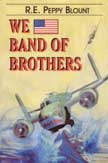|
|
|
|
| Missing In Action (MIA) | Prisoners Of War (POW) | Unexploded Ordnance (UXO) |
| Chronology | Locations | Aircraft | Ships | Submit Info | How You Can Help | Donate |
|
 by R. E. Peppy Blount Eakin Publications 1984 Softcover 393 pages Index, photos ISBN: 0890154430 Cover Price: $24.95 Language: English Order now at amazon.com Return to |
We Band of Brothers I picked this book up with some trepidation having originally confused Peppy Blount with "Pappy" Gunn who had revolutionized the use of the B-25 Mitchell bomber as a strafing platform. But if "Pappy" Gunn provided the weapon, it was men of the caliber of Peppy Blount who used them to devastating effect. "We Band of Brothers" covers the operations of the 501st "Black Panthers" squadron of the 345th Bomb Group, the legendary "Air Apaches." Blount joined up with them in November 1944 at the simple coastal strip at Tacloban in the Philipinnes, and while many may have thought the war was nearing its end, for Blount it was only the beginning. The next base was at San Marcellino in Luzon, but far from the tropical paradise one may imagine, it was "the dirtiest, driest, dustiest, hottest base of operations yet encountered." I was also surprised just how much detail the long tall Texan gets into the book. We have all read of those long range bombing missions where the planes would just get back on fuel vapours, but Blount's description of the return from an eleven hour raid that hit targets deep in China is riveting stuff. Having "sweated the gas" a few times myself I can imagine how nasty it would be knowing that running out of gas meant ditching the plane rather than just pulling off to the side of the road. The Mitchell was supposed to have a maximum air time of six hours but with addition of "Tokyo" fuel tanks in the bomb bay, this could be almost doubled. Jimmy Doolittle had used them during the famous carrier raid on Tokyo from the deck of a carrier. Despite the added fuel tanks, the planes still had room for four 500 pound bombs. Extra tanks were also added in the radio compartment behind the bomb bay, and one of Blount's crewmen would "top off" the tanks prior to departure. The strafers used the fuel reserves to the limit, heading further and further into China and later staging out of Palwan and skip bombing Jap freighters moored in Saigon. The story of this raid is the climax of the book. Some other experiences such as being tossed around by massive weather fronts and being trapped in a dead end canyon desperately trying to get enough height to get out put you right in the pilot's seat and make you appreciate just how good you had to be to keep those planes in the air. They got every bit out of those planes make no mistake. But it was the fourteen .50 calibre guns that gave the strafers their main firepower and Blount's descriptions of them in action certainly put you into the pilot's seat as the button is pushed. There were eight guns in the nose, four more in two gun packages at the side of the plane plus the two guns from the top turret firing forward with the others. They would regularly melt barrels during the strafing runs and the ground crew regularly replaced them after each mission. The attacks on shipping convoys make great reading. With so much firepower, Blount would fantail the plane as he strafed so he swept the target ship like a firehose. The guns were originally offset a few degrees to fire downwards, but by the time Blount got to fly them they were aligned directly ahead so that you had to aim directly at the target to hit it. And these guys flew low, often too low as it was easy to become fixated on the target and not allow enough time to pull out. The aiming sights were rarely used as they would add to the problem, so the pilot would just fly directly at whatever he wanted to hit. The co pilot had the job of ensuring the plane pulled out in time. Also prior to the strafing or bomb run, the crew would drape a 50 pound flak suit over the pilot, giving him some feeling of protection, a lot more than the men he targeted would feel. The men were of course very religious and Blount certainly gives us an insight into the airman's "prayer meetings." For young men living on the edge and losing friends on every mission, such boozy gatherings were a vital part of survival. They would often be timed to follow the arrival of the monthly B25 flight down to Sydney for "provisions". I mentioned that I had enjoyed the book to another 345th BG veteran who told me Blount thought he had won the war on his own. I guess all the good pilots felt that way. Blount's book certainly gives an insight into just how important it was to be a very good pilot in order to bring your plane and crew back from their missions. And it is a great read. Reprinted 2000. Review by Phil Bradley Return to Book Reviews | Add a review or submit for review |
| Discussion Forum | Daily Updates | Reviews | Museums | Interviews & Oral Histories |
|